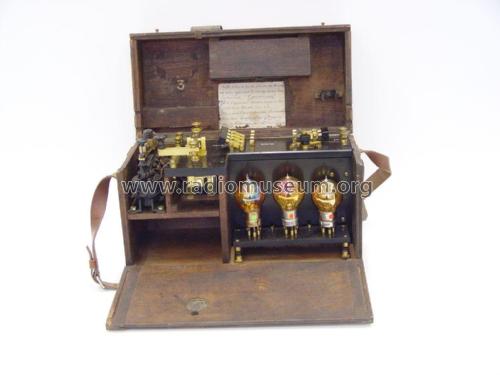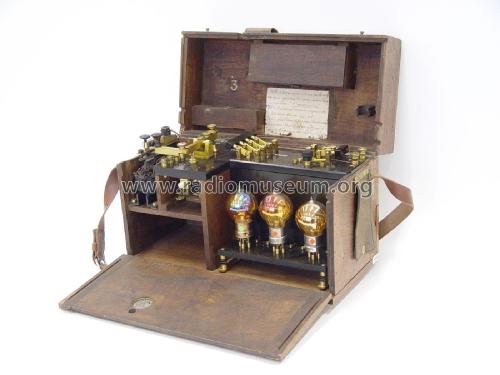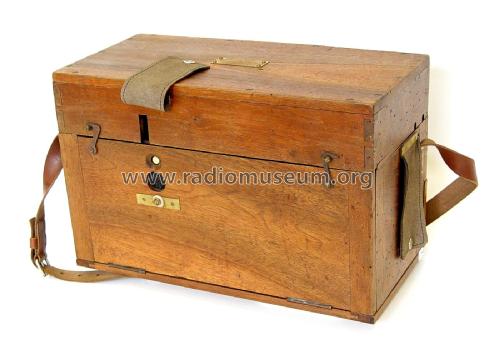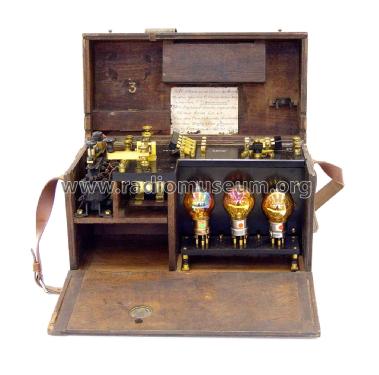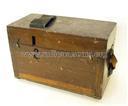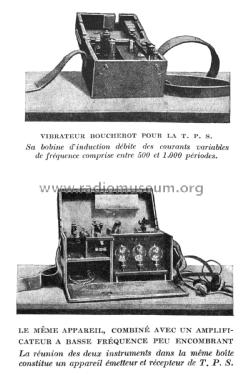Émetteur-Récepteur de TPS (Télégraphie par le sol) Boucherot (military)
Électron, Ateliers de Construction; Lyon
- Paese
- Francia
- Produttore / Marca
- Électron, Ateliers de Construction; Lyon
- Anno
- 1917 ?
- Categoria
- Attrezzature Morse & TTY, RTTY, TDD etc.
- Radiomuseum.org ID
- 278251
- Numero di tubi
- 3
- Principio generale
- Amplificatore audio; 3 Stadi BF
- Gamme d'onda
- - senza
- Tensioni di funzionamento
- Batterie (di accumulatori e/o a secco) / 4 & 40 Volt
- Altoparlante
- - Per cuffie o amplificatori esterni
- Materiali
- Mobile in legno
- Radiomuseum.org
- Modello: Émetteur-Récepteur de TPS Boucherot - Électron, Ateliers de
- Forma
- Apparecchio portatile > 20 cm (senza la necessità di una rete)
- Dimensioni (LxAxP)
- 420 x 270 x 200 mm / 16.5 x 10.6 x 7.9 inch
- Annotazioni
-
Modèle identique fabriqué par Ch.Beaudoin et autre(s).
La télégraphie par le sol a été utilisée pendant la guerre de 1914/18 pour établir des liaisons à courte distance (portée 3 km environ). Elle évitait l'utilisation d'une ligne téléphonique sujette aux coupures lors des bombardements.Le principe est relativement simple. L'émetteur injecte dans le sol, entre 2 piquets métalliques (prises de terre) distants d'une centaine de mètres, un courant vibré commandé par le manipulateur de signaux Morse.Le vibrateur qui délivre le courant vibré est analogue à un mécanisme de sonnerie, muni d'un enroulement secondaire pour élever la tension.La réception s'effectue entre deux piquets métallique fichés dans le sol, distants d'une centaine de mètre. Le signal capté entre ces piquets est extrêmement faible et doit être amplifié avant d'être applique au casque d'écoute (amplificateur à 3 lampes).Regardez aussi Telegraphie par sol T.P.S. TM 2 Bis.
Telegraphy through the earth was utilised during WWI to establish communication at short distances (+- 3 KM) to avoid a wired telegraphy connection prone to enemy bombing.The principle is simple enough. The transmitter injects in the earth, between 2 poles a 100 meter apart, a vibrating current initated by the telegraph morse key.The vibrator delivering the vibrating current is analog to a doorbell mechanism, but having a secondary winding to augment the voltage.The reception of the vibration is done with an analog system of 2 poles in the earth, distant of about 100 meters from each other. The received signal between the poles is extremely weak and has to be amplified before running it through headphones (3 valve amplifier).See also Telegraphie par sol T.P.S. TM 2 Bis.
- Peso netto
- 9.9 kg / 21 lb 12.9 oz (21.806 lb)
- Bibliografia
- La Science et la Vie, Aout 1920
- Autore
- Modello inviato da Christophe Howald. Utilizzare "Proponi modifica" per inviare ulteriori dati.
- Altri modelli
-
In questo link sono elencati 1 modelli, di cui 1 con immagini e 0 con schemi.
Elenco delle radio e altri apparecchi della Électron, Ateliers de Construction; Lyon
Collezioni
Il modello Émetteur-Récepteur de TPS (Télégraphie par le sol) Boucherot (military) fa parte delle collezioni dei seguenti membri.
